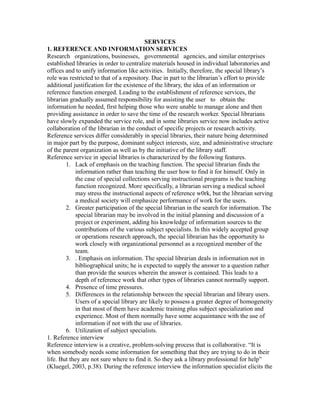The document discusses various services provided by special libraries, including reference and information services, bibliographic services, literature search services, indexing and abstracting services, and current awareness services. Reference services in special libraries are characterized by an emphasis on finding information rather than teaching users how to find it themselves. Special librarians also often collaborate more closely with users by participating in the initial planning of projects. Bibliographic services involve acquiring, cataloging, and managing library materials and records. Literature search services include conducting comprehensive literature reviews like scoping reviews, systematic reviews, and meta-analyses to summarize existing research on a topic. Indexing and abstracting services help organize information and allow users to efficiently find relevant materials. Current awareness services involve regularly reviewing

![information needs of the client. This can be a delicate and complex process (Just ask,
2006, p.34).
Communication channels included in reference services are:
o In-person visit to the library o Telephone
o Fax
o E-mail
o Web-based services
o Chat reference
o Co-browsing
o Instant messaging
o Videoconferencing: enables people in different locations to see and hear eachother and
co-operate on their computers via telephone lines (in a conference)
o Voice over IP: for disabled persons
o Cellular phones: PDA (Portable Digital Assistants: promotion of services,advertisement
of exhibitions and events, messages as information on events, reminders for overdue
items, announcement on reserves, answers to questions) o Palm-top
Objectives of the Reference interview
It has to find out what and how much information a user needs. That depends on the user
who asks the question [when a scientist and a child ask “do you have something on
horses?” the librarian will ask different questions, search in different ways and bring
different kinds of information to each of the two patrons].
The librarian formulates a search strategy and translates the user’s terms into key words
An objective is the evaluation of the information found.
What is an enquiry?
An enquiry is a transaction where a staff member tries to:
ƒ Find or recommend resources within the library or online.
ƒ Assist in the use of these resources.
ƒ Answer the question either through the use of library tools, databases or websites.
Reference process
The reference process consists of three primary elements:
The information. It is found in many formats (books, magazines, journals, electronic resources,
Internet and databases).
The user/patron/client/end-user/customer. This is a person who comes to the physical or virtual
library within enquiry and seeks assistance by the reference librarian.
The reference librarian. S/he is the mediator between the information and the
user. S/he is the person who interprets the question, identifies the proper source for the
answer and judges if the answer is adequate. The reference librarian acts as an instructor
for the user (Katz, I, p.10).
Reference questions
The queries can be divided into two general types, depending of the knowledge
auser has on a topic:
a. The user asks for a known item ,e.g. document, book and journal article. The reference
librarian searches the library’s catalog, a bibliography or a database.
b. The user asks for information but his/her knowledge on the topic is limited. That query triggers
the reference interview.
Categorization of questions](https://image.slidesharecdn.com/services-160511065533/85/Services-2-320.jpg)










